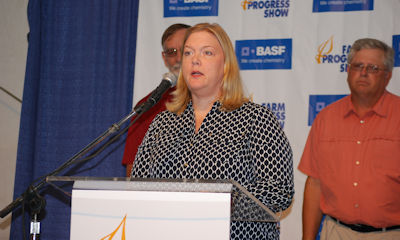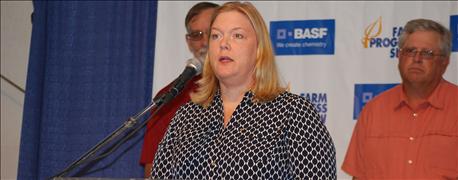August 31, 2016

Major food and agricultural supply chain companies, along with conservation organizations, launched a partnership to improve soil health, water quality and water conservation efforts. The new initiative – the Midwest Row Crop Collaborative (MRCC) - will provide needed support for farmers in their pursuit of further conservation efforts to reduce nutrient loss and protect water supplies.
The MRCC’s goal is to reduce nutrient loss flowing into the Mississippi River Basin, which aligns with goals set forth in state Nutrient Loss Reduction Strategies, and to take pressure off the Ogallala Aquifer.

“Consumers want to know where their food came from,” says Jill Kolling, senior director of sustainability for Cargill. “We want to do a better job helping consumers understand there is a family farmer behind this (food products) and that farmers are already doing great things.”
The joint announcement at the 2016 Farm Progress Show came from founding companies and organizations including Cargill, Environmental Defense Fund, General Mills, Kellogg Company, Monsanto, PepsiCo, The Nature Conservancy, Walmart, and World Wildlife Fund.
“As an agriculture and food company, Cargill sees the collaborative as an essential way to support and accelerate the adoption of existing conservation programs designed by farmers and to recognize the good work that’s already been done,” says Jill Kolling, senior director, sustainability, Cargill. “It’s about providing solutions that make sense to farmers, the environment and the consumers.”
Kolling says the collaborative was initiated by Wal-Mart.
“We believe customers shouldn’t have to choose between food they can afford and food produced in a sustainable way,” says Ryan Irsik, director of public affairs for Wal-Mart. “This commitment starts here in the fields of Iowa, Illinois and Nebraska.”
CEOs from MRCC partnering companies gathered two years ago in Bentonville “to talk about ways to advance agriculture in the Midwest” and enhance conservation efforts. They also want consumers to understand where their food comes from and that farmers are good stewards of the land.
“Consumers want to know where their food came from,” Kolling says. “We want to do a better job helping consumers understand there is a family farmer behind this (food products) and that farmers are already doing great things.”
Those “great things” include the Soil Health Partnership, an initiative from the National Corn Growers Association, consisting of 65 farmer partners who test conservation practices such as cover crops, conservation tillage, no-till or strip-till on a field-scale. MRCC hopes to help increase participation in the partnership and expand the reach to 100 farms.
Conservation in practice
Roger Zylstra, a corn, soybean and hog farmer from Jasper County, Iowa, participates in the Soil Health Partnership. He classifies two-thirds of his land as “highly erodible” and uses no-till and conservation tillage - a practice he’s used for more than 30 years.
“I enrolled in the Soil Health Partnership program because I didn’t think continuous no-till was improving my soil health as quickly as I wanted it to,” says Zylstra. He plans to add cover crops to improve soil health and manage erosion. “I also think cover crops will help retain nutrients from fall-applied manure so it doesn’t contribute to water quality problems.”
Zylstra says part of the challenge for implementing recommended conservation strategies is that every farm is different. A farmer incorporating cover crops into a system that uses manure is different from an operation that applies chemical fertilizer. He says the goal is to identify these differences and associated costs to implement different conservation strategies, and then calculate the return on investment from the implemented practices.
Support from MRCC will go towards helping the Soil Health Partnership collect data this data and identify best practices for various environments, in hopes to fast-track conservation practice adoption on more farms.
“This funding is significant to me because we now have more support from the large food and ag companies and environmental groups pushing for change. They’re showing us we don’t have to do it alone,” says Zlystra. “Farmers are, and can be, part of the solution.”
You May Also Like




